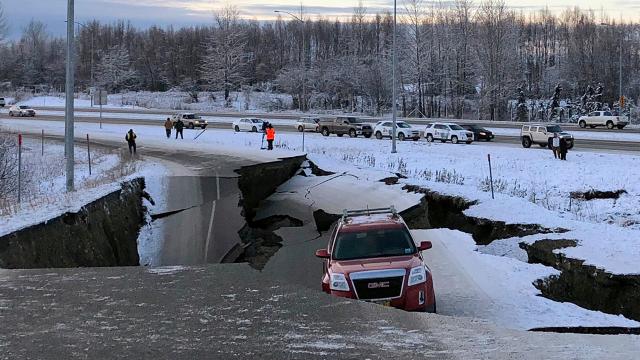Alaska is now beginning to survey the damage of powerful back-to-back earthquakes that struck the area around Anchorage on Friday, an event that resulted in damage to buildings, roads, and other infrastructure. Speaking with reporters following the quake, Alaska Governor Bill Walker said that resulting disruption and needed repairs could last “quite some time.”
A magnitude 7.0 earthquake struck around 8:29am local time followed by ensuing, smaller earthquakes. Citing United States Geological Survey research geophysicist Gavin Hayes, CNN reported Saturday that “a magnitude-5.2 aftershock about 11 p.m. Friday was the second-biggest event since a magnitude-5.7 temblor hit minutes after the main quake.”
Despite earthquakes being common in the area, Friday’s event was still significant.
“This is a very earthquake-prone region. Much more so than California,” climatologist Brian Brettschneider told Gizmodo by email. “That said, it’s been over 50 years since an earthquake this strong was felt in Anchorage. The good news is that most of Anchorage was built, or rebuilt, after the great 1964 Earthquake (M9.2). That means very strict building codes.”
He also noted that there were no injuries or fatalities, adding: “If you had to be in a city of over [a quarter of a million] people and have an M7 earthquake hit, this is the best place to be.”
Drone video of cracks in Waldron Lake in Anchorage (WPAA2). Ice was 8.0″ thick yesterday. 8.0″ ice can hold ~6,500 lbs. The cracks have partially flooded the lake and created lots of slushy areas. @NWSAPRFC pic.twitter.com/C7UiAZ7ics
— Brian Brettschneider (@Climatologist49) November 30, 2018
Videos shared on social media captured widespread damage across Anchorage and the surrounding area. One video shared by Brettschneider on Twitter captured drone footage of cracks in ice at Anchorage’s Waldron Lake. According to Brettschneider, the ice was 20cm thick.
Nat Herz, a reporter for Alaska Public Media, told NPR that he was sitting at a coffee shop in Anchorage when he “just felt like sort of a rumble or a buzz.”
“But then things kind of got louder, and things started really shaking and shaking hard. And people were kind of looking around,” he told NPR. “And then I think, you know, someone went for the door, and everyone else went for the door. And, you know, everyone kind of hurried outside. And kind of once things settled down, everyone went back in.”
Here’s a map showing the magnitude 7.0 along with all of the aftershocks we reviewed in the 7 hours after the quake. Most aftershocks have not yet been reviewed and are not on this map, but these precise locations give a good overview of the sequence so far. pic.twitter.com/FM7oZL7t4n
— AK Earthquake Center (@AKearthquake) December 1, 2018
At least two highways were closed down following the earthquake, with local CBS affiliate KTVA reporting that area’s Glenn Highway endured significant damage that included a “massive sinkhole.” Power losses also reportedly affected tens of thousands of people following the initial earthquake.
Governor Walker said in a phone interview Friday that there’s a possibility that some infrastructure damage could take weeks or months to repair, especially given the US winter season. Walker also said he spoke with US President Donald Trump, after which call KTVA reported the Federal Emergency Management Agency approved assistance for the area.
This is what happened on the 6th floor of the Nesbett Courthouse during the Anchorage #earthquake. Both attorneys jumped under their desks. Evacuated the building after the shaking stopped. pic.twitter.com/dqHGPCv6XO
— Heather Hintze (@HeatherHintze) November 30, 2018
“It’s going to be a disruption for quite some time,” Walker said. “We’ve been on the phone with the White House a number of times today [and] took a call from [US] President Trump. They talked about their desire to help us, and we appreciate that very much.”
According to Alaska Public Media, schools in the area are expected to be closed until at least Wednesday of next week.
